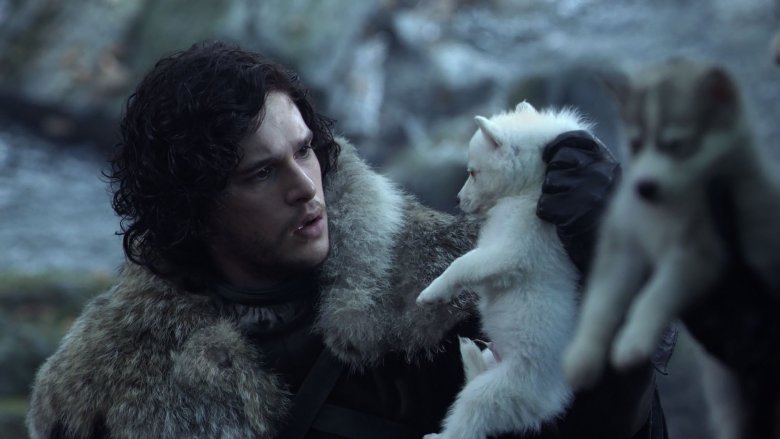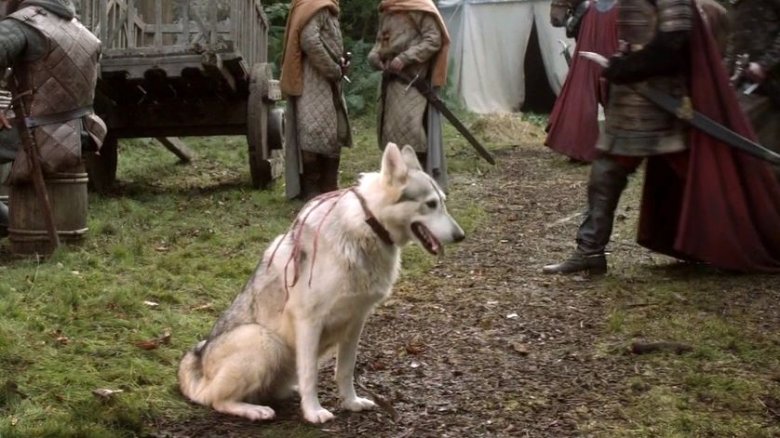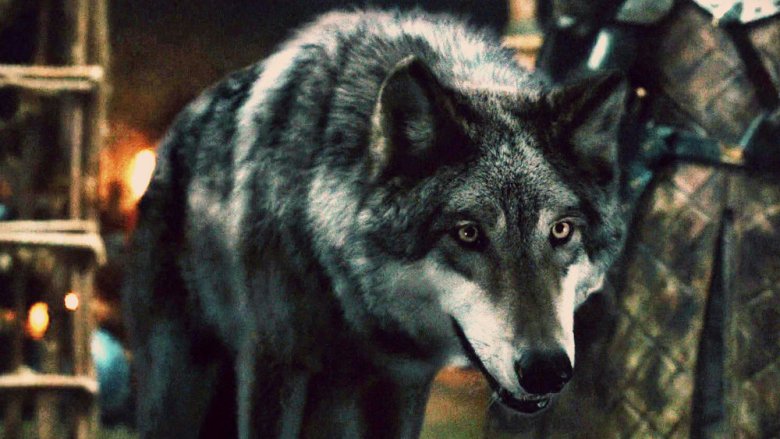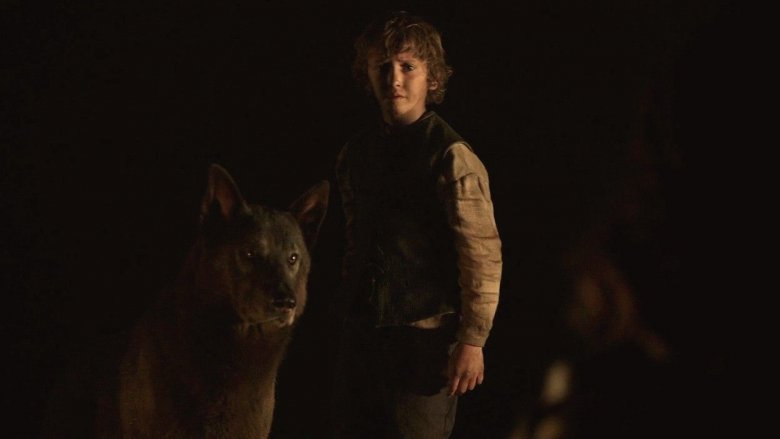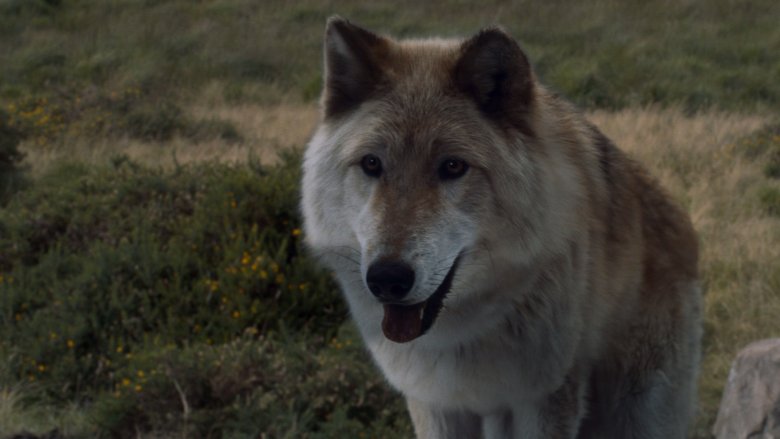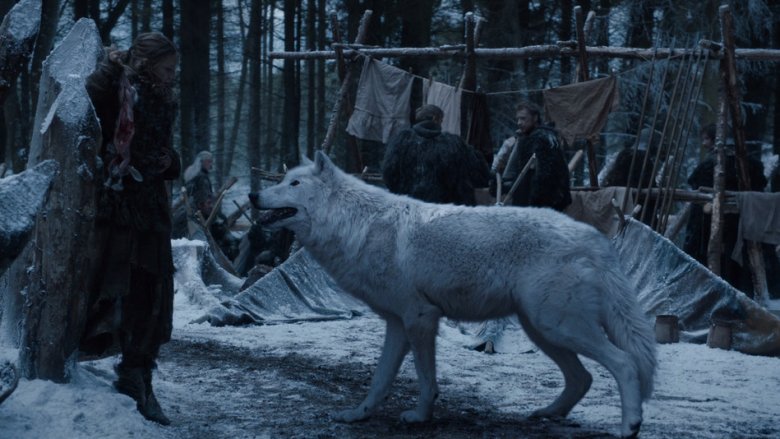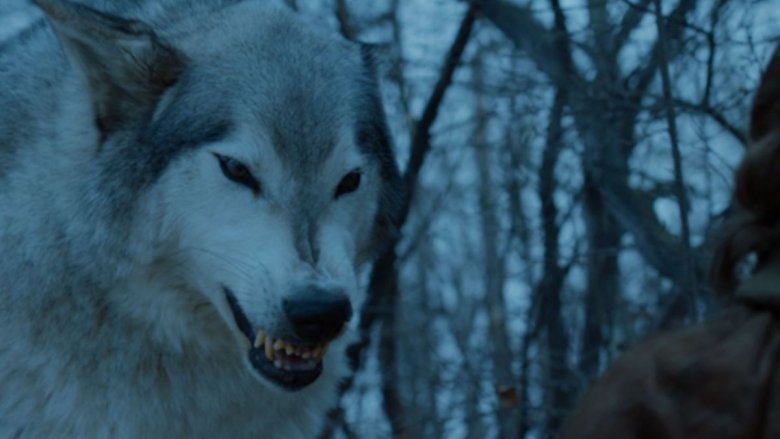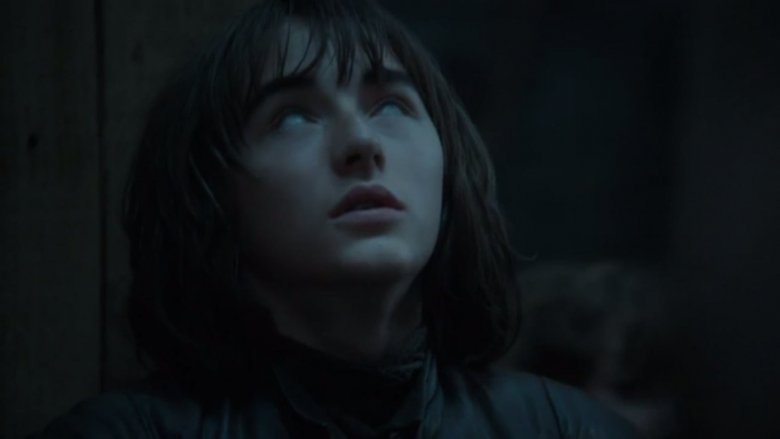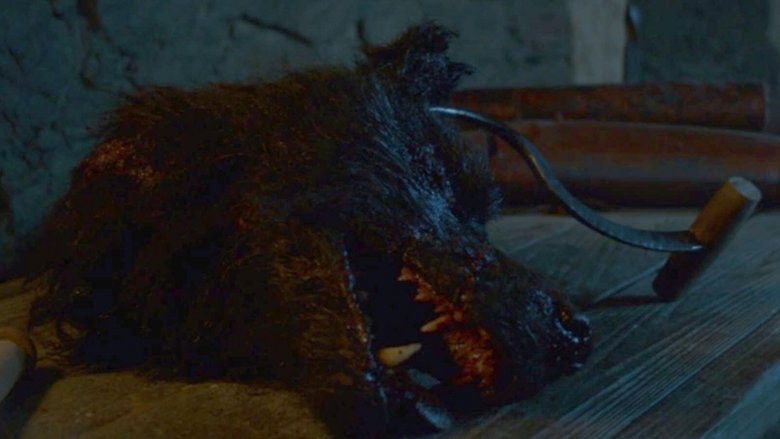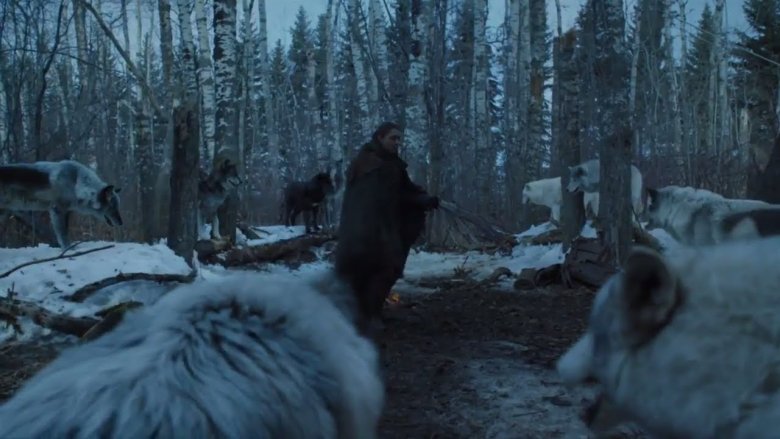Why The Direwolves Are Even More Important To Game Of Thrones Than We Realized
As the final season of Game of Thrones nears, shrouded in a heavy fog of secrecy, fans of the hit HBO fantasy series are combing over every piece of information the show has given us so far in the search for clues regarding how it all will end. That means looking at every location, every storyline, every line of dialogue, and every character... including the non-numan ones.
We met the Stark family direwolves well before we met many of the show's most important human characters, and the series made it immediately clear that the six pups were an omen, that they were connected to the Stark family in some clear way. Since then, as the Stark children have suffered, so too have their beloved pets, in all manner of ways. But, while we're often focusing just on the human characters, the direwolves may be showing us things about the story that are just as important, including key character building moments for their human masters, and foreshadowing for some vital aid in the battles to come. Let's take a look at why the Stark direwolves are more important than some viewers give them credit for.
A pattern begins
It took almost no time at all for the Stark direwolves to get into trouble, and that first sign of trouble began a pattern of metaphorical mirroring that has continued throughout the series. It started on the Kingsroad, when Arya Stark's direwolf Nymeria attacked Prince Joffrey, leading Queen Cersei to call for the wolf's death. To prevent this, Arya shooed Nymeria off into the woods, and Cersei decided the punishment must be given to Sansa's direwolf, Lady, instead. So, Ned Stark killed his daughter's blameless pet at the command of the king, and Sansa Stark was left heartbroken.
What happened to Lady turned out to be the beginning of a long pattern of mistreatment that has followed Sansa for much of the show, despite her doing nothing wrong other than perhaps holding a very naive view of how the world really works. Sansa was traded around like a marriage token, taken prisoner, raped, and generally emotionally tormented for several seasons before finally fighting her way out and taking her place as Lady of Winterfell. Lady was more than just fodder for tragedy. She represents the original injustice against Sansa, and the spark that ignited within the eldest Stark daughter and allowed her to survive, and ultimately prevail.
The North Remembers
When his father was executed, Robb Stark called the banners of the North and launched a war against the Lannisters, and he brought his direwolf Grey Wind with him. Grey Wind was the first creature of his kind seen in the south in centuries, and he served as both a force of intimidation and an invaluable covert operative in Robb's war. Then the Red Wedding came, and Grey Wind was killed along with his master. After that, as part of one last act of cruelty, Grey Wind's head was stitched on top of Robb's decapitated body, and the monstrosity was paraded around the Twins.
The mutilation of Robb and Grey Wind was meant to serve as an insult to and mockery of the Stark army and family, but time tells a different story. Yes, the North was briefly brought low under the banners of the Boltons and the Freys, but the Starks rose again under the leadership of Sansa and Jon, and Arya ultimately returned to enact a slaughter at the Twins of her own. One of the show's most important battle cries, "The North Remembers," originated with the death of Ned Stark, but the execution and mockery of Robb and Grey Wind only made it stronger.
The last shred of innocence
Rickon Stark's direwolf Shaggydog is maybe the least involved in any of the Stark affairs (except perhaps for Lady, who barely had time to do anything of substance before she was killed). Shaggydog followed Rickon around for six seasons, but since Rickon barely did anything, Shaggy didn't do much either, before he was ultimately slaughtered as a bargaining tool by the Umbers, in their pursuit of peace with the Boltons.
With all of that in mind, Shaggydog might not mean much to a lot of Stark fans, but Rickon and his direwolf represented something important. They were the last shred of innocence in the family, a boy and his pet who'd done nothing but stay close to their loved ones and done the best they could to survive. Rickon met his end as a Ramsay Bolton's plaything before the Battle of the Bastards, and Shaggydog was used as yet another token... or was he? More on that shortly.
It's a powerful and heartbreaking reminder that nothing remains pure forever in Westeros, even when victory seems close.
A great sacrifice
Summer, Bran Stark's direwolf, was an important companion to his master for more than just friendship and safety. Early on, Bran began having dreams in which he was walking in Summer's body, which proved to be an important harbinger of his own later abilities as the Three-Eyed Raven. Eventually, Bran found himself able to "warg" into Summer's body and scout the landscape, making his direwolf more than just his friend and protector, but an extension of his own damaged body.
So it was particularly resonant when Summer died at the cave of the Three-Eyed Raven, defending his master with his last breath as Bran escaped the wight attack. Bran must have felt as though a part of himself died with Summer, and though his enlightened state has left him rather emotionally detached, it's hard to imagine part of him doesn't feel that loss still. It's also hard to imagine he won't revisit that feeling again.
The one who stayed
Ghost is the only surviving Stark direwolf that has stayed with his master, making him the direwolf we've seen onscreen the most throughout the show's run. Ironically, he was the runt of the litter when the Stark children found him, and was given to Jon amid jokes from Theon. Jon and Ghost were a pair of outcasts, and now they've proven to be a pair of survivors.
It should go without saying that if Ghost dies, Jon will be particularly affected. The direwolf stayed with him even during his own death, and didn't ever falter in his loyalty even after Jon returned from beyond. There may be even more to Ghost than his loyalty, though. When Jon ventured out into the lands Beyond the Wall, Ghost would occasionally leave his side to explore the forests, where it's said other direwolves might still live in the wild. It's possible Ghost knows corners of the far North that no man has even dreamed of, and that knowledge could come in very handy as the final battle against the army of the dead looms.
The pack survives
Nymeria, Arya Stark's direwolf, remained one of the show's greatest mysteries for years. Arya drove her away from the Kingsroad after she attacked Joffrey to save her life. We then heard nothing from the direwolf as Arya served Tywin Lannister in secret, escaped Westeros for Braavos, trained to be a Faceless Man, and ultimately returned to seek vengeance on behalf of her family. Then, last season, we finally learned that all the while Nymeria was roaming the North, and ultimately formed a pack of regular wolves to lead.
In a powerful scene, Arya and Nymeria meet, and while the wolf clearly recognizes her former master, she's also not keen to follow her. The two part ways... for now.
Nymeria's ultimate fate is the subject of much speculation amid Thrones fans, and depending on how the final season goes, that may be her greatest legacy. She also serves as something just as important, though: a reminder to Arya that lone wolves don't survive, and that she needs to reconnect with her family if she hopes to carry on.
Bran's gifts
With the remaining direwolves set in their apparent roles and the final season approaching, there are a number of theories regarding how the animals might factor into the final episodes of Game of Thrones. One of them, of course, concerns Bran Stark and his ability to warg into various animals. Bran's status as the Three-Eyed Raven has made him aloof and seemingly cold, but he also still retains certain loyalties, as we see in his efforts to help Arya and Sansa convict and execute Littlefinger at the end of Season 7. He's also clearly committed in many ways to Jon's efforts to defeat the army of the dead, but despite his tremendous mental gifts, Bran Stark can't physically fight.
So, what can he do? Well, Bran can warg into direwolves, as evidenced by the times he did it with his own wolf, Summer. Would Jon allow Bran to warg into Ghost and fight alongside him on the battlefield, or even just to use Ghost's body (and his inherent knowledge of the lands beyond the Wall) for scouting purposes. It remains to be seen, but it's quite possible Bran's tendency to project his consciousness into direwolves hasn't lapsed yet.
A faked death?
Death on Game of Thrones comes frequently and brutally, but it's also not exactly a 100% concrete concept. Theon Greyjoy famously faked the deaths of Bran and Rickon Stark and got away with it for a little while, and Jon Snow was brutally murdered only to return from the dead a short time later. There are ways of getting around dying, but even more ways of getting around the truth, which has prompted plenty of fan theories with regard to who is or isn't dead.
One such theory emerged back in Season 6, after the Umbers seemed to confirmed that Rickon's direwolf, Shaggydog, had been killed and decapitated. We saw the wolf's somewhat battered severed head and Ramsay Bolton even claimed he was using its skin as a rug, but we never actually Shaggydog die, and this prompted a fan theory that the Umbers were somehow faking the direwolf's death for the sake of tricking Ramsay and ultimately turning on him in favor of the Starks. Of course, this theory was first floated back when Rickon was still alive, so it's not clear how it would still work after Ramsay killed him, but even if that's not true... could Shaggy be out there somewhere? Probably not, but it's fun to think about.
A direwolf army
For ages now, Jon Snow has told anyone who will listen that the only war that matters is about to come to Westeros, and the end of Season 7 proved that he was correct. The army of the dead, led by the Night King, is on the march, heading south of the Wall, and the armies of men have to do everything in their power to stop it before darkness swallows everyone and everything up and the world as all living things know it comes to an end.
This pull-out-all-the-stops approach has already led to some unlikely alliances and even a few foolish betrayals, but just how far does the edict go? How much help could Jon, Daenerys and their allies really get? Well, there's one fan theory going around which suggests that Nymeria, Arya's direwolf, is traveling around Westeros gathering more and more wolves and dogs to her pack, building a kind of canine army that will ultimately arrive when needed to help fight the dead. Given the intelligence of the Stark direwolves, their ability to follow strategies and their sense of loyalty, it's not as far-fetched as it might sound. Plus, it's quite possible that Ghost has met some direwolf friends of his own north of the Wall. Horses might not be the only four-legged friends helping in the final fight.
